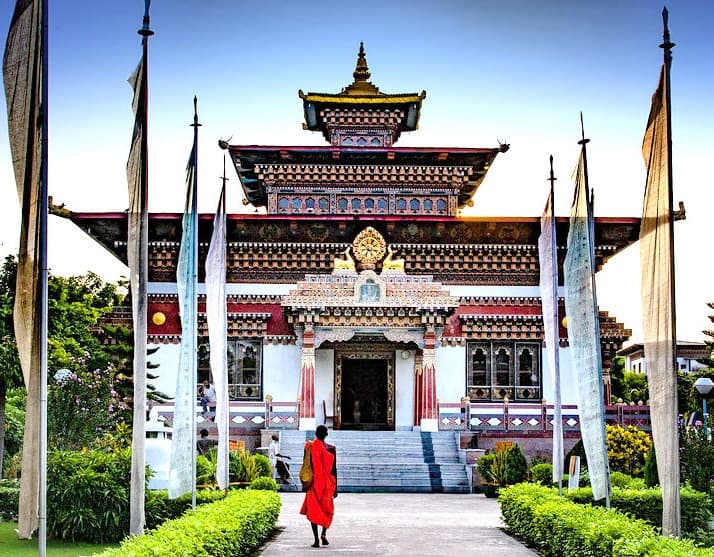A tantalizing culinary journey with our guide to the Flavor of Bhutan: Savoring the Unique Bhutanese Cuisine. Nestled among the mighty Himalayas, Bhutan offers more than just breathtaking landscapes—it presents a vibrant array of traditional dishes that reflect its rich cultural heritage. This blog explores the bold and distinctive flavors of Bhutanese cuisine, from the fiery Ema Datshi, Bhutan’s beloved national dish, to the comforting warmth of Jasha Maru and the unique nuttiness of Red Rice. Perfect for food enthusiasts and cultural explorers alike, discover how these simple, yet profound ingredients create a palate that’s uniquely Bhutanese, making every meal a memorable experience. Whether you're a seasoned traveler or a culinary novice, prepare to indulge in the tastes of Bhutan, where every dish tells a story of tradition and flavor.
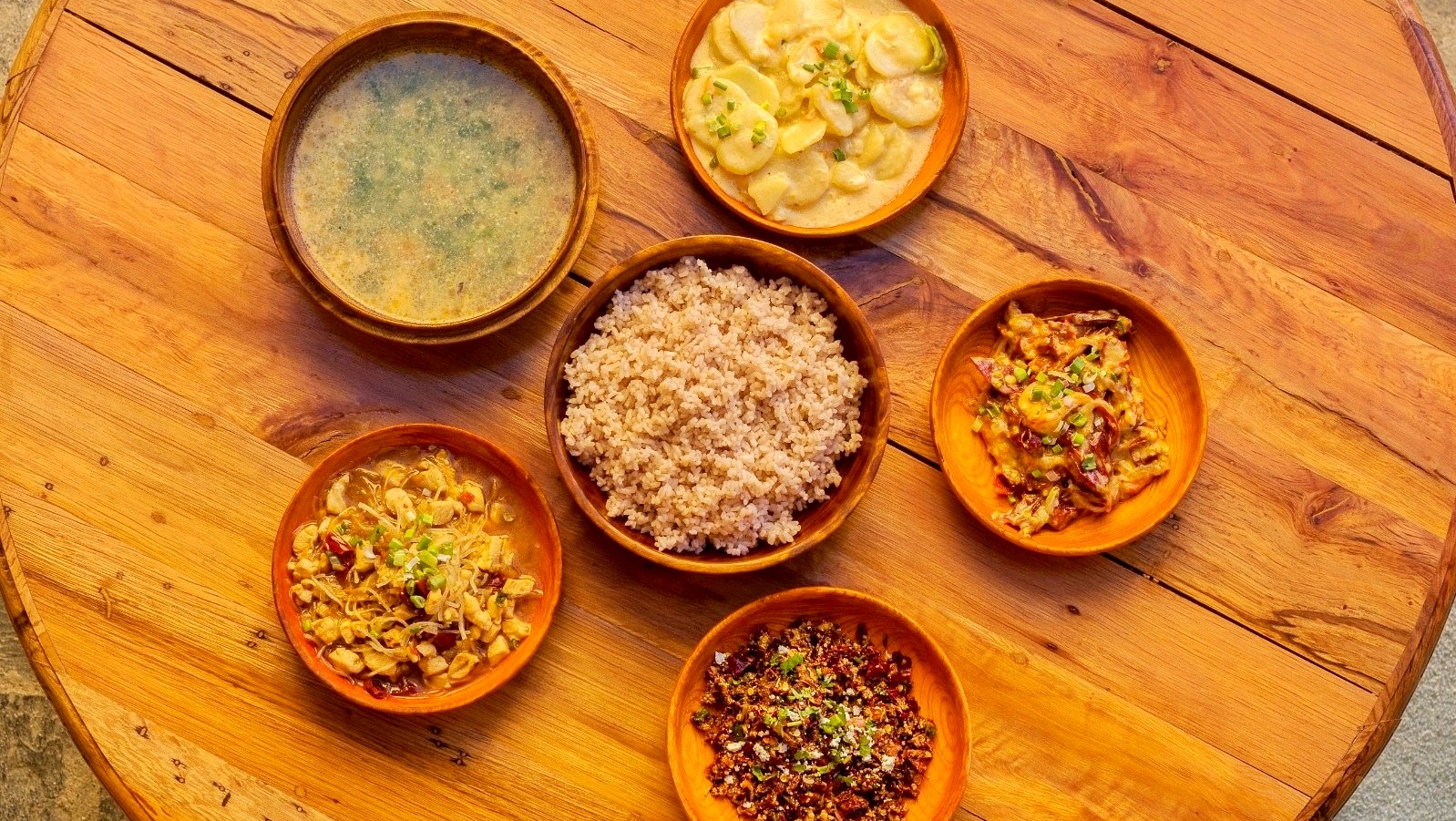
Discover the true Flavor of Bhutan with Druk Holidays, your go-to source for experiencing Bhutanese cuisine. With our expertly crafted tours, we take you straight to the heart of Bhutan’s culinary scene. Enjoy authentic dishes like Ema Datshi and Jasha Maru as part of our tailored travel experiences. Whether you’re a food lover or just looking to try something new, Druk Holidays ensures that you get a taste of Bhutan’s unique and vibrant food culture. Join us for an unforgettable journey into the flavors of Bhutan.
Ema Datshi
Ema Datshi is not just a dish; it's a cornerstone of Bhutanese cuisine and a vivid expression of the country's culinary identity. The name translates to "chili cheese," which aptly describes its two main components: chili peppers and a local variety of cheese known as Datshi. This dish beautifully represents the Bhutanese love for intense flavors and their ingenious use of local ingredients.
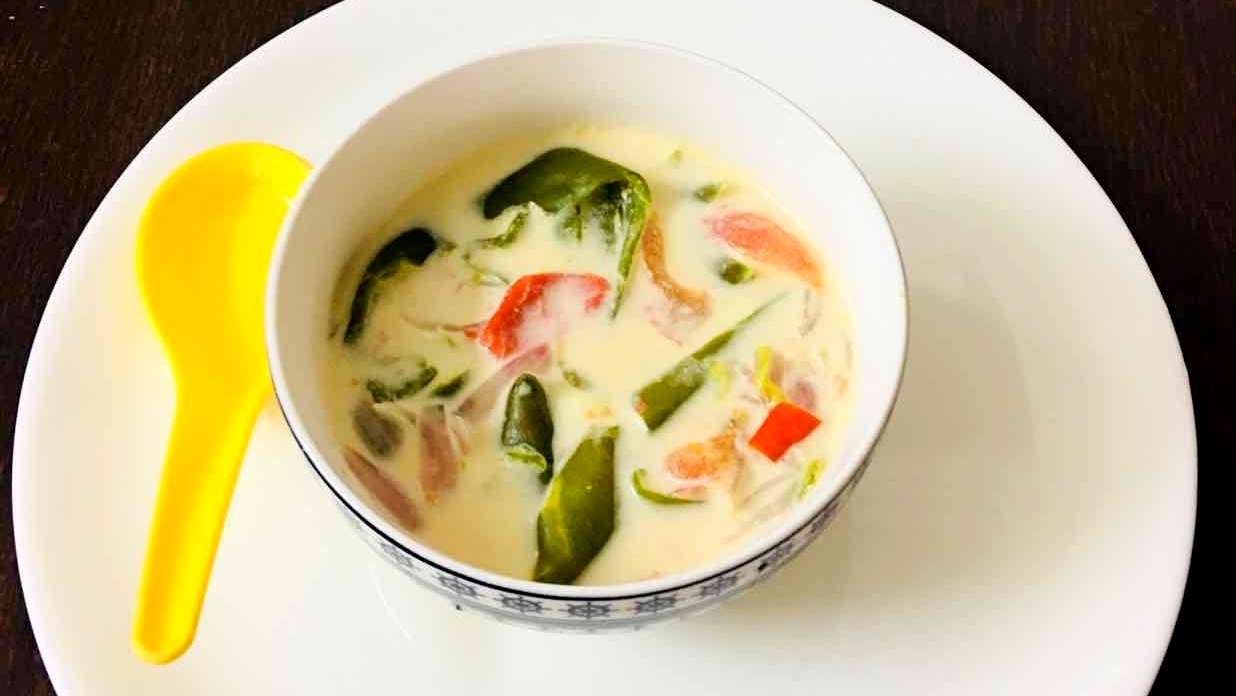
Ingredients
- Chili Peppers: The backbone of this dish, chilies can vary in heat and type. Most commonly, green chilies are used, but red or yellow chilies can also be found in different variations.
- Datshi Cheese: This is a traditional Bhutanese cheese that is somewhat similar to cottage cheese but more robust in flavor. It melts beautifully, creating a creamy and rich sauce.
- Garlic and Onions: These are used to add depth and aroma to the dish.
- Tomatoes: Optional in some variations, tomatoes add a tangy sweetness that balances the heat of the chilies.
- Butter or Oil: Used for cooking the ingredients together until the flavors meld.
Preparation
The preparation of Ema Datshi is simple yet requires a delicate balance of flavors. The chilies are sliced and combined with chopped onions, garlic, and sometimes tomatoes. This mixture is then sautéed in butter or oil before the cheese is added. Water or broth is often poured in to allow the ingredients to simmer together until the cheese melts and the chilies are tender. The result is a thick, spicy stew that is both creamy and fiery.
Serving
Ema Datshi is traditionally served with Bhutanese red rice or buckwheat pancakes, which help temper the spiciness of the dish. It is typically eaten with a spoon or used as a dip with chunks of the pancake.
This dish is not only a staple in every Bhutanese household but also a must-try for any visitor to Bhutan. It encapsulates the bold and hearty essence of Bhutanese cooking, making it a beloved and enduring symbol of the country's rich culinary traditions.
Jasha Maru
Jasha Maru is a classic Bhutanese dish, cherished for its simplicity and rich flavors. Often referred to as a Bhutanese chicken stew, this dish exemplifies the traditional cooking methods and the use of fresh, local ingredients prevalent in Bhutanese cuisine. Its hearty and comforting qualities make it a favorite among both locals and visitors alike.
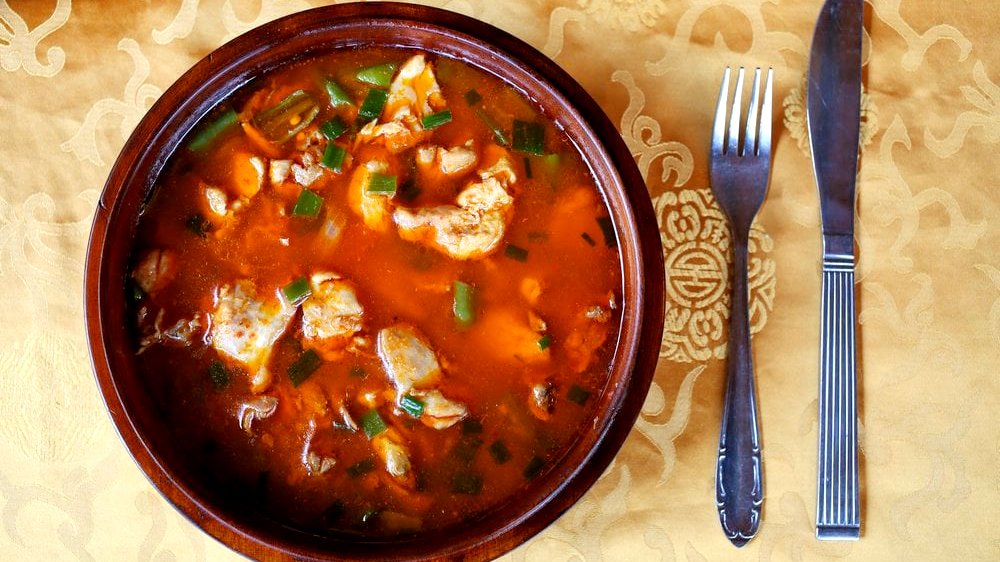
Ingredients
- Chicken: Typically, bone-in chicken pieces are used for their flavor and juiciness.
- Onions and Tomatoes: These vegetables form the base of the stew, adding sweetness and a mild acidity that balances the dish.
- Garlic and Ginger: Essential to Bhutanese cooking, these aromatics add depth and a distinctive kick.
- Chilies: Fresh or dried, chilies introduce a gentle heat, which can be adjusted to taste.
- Coriander: Often used both during cooking and as a garnish, coriander introduces a fresh, herbal note.
- Oil or Butter: Used for sautéing the ingredients, enhancing their flavors.
Preparation
The preparation of Jasha Maru involves sautéing finely chopped onions, tomatoes, garlic, and ginger in oil or butter until they are soft and aromatic. Chicken pieces are then added to the mix and browned. Water is poured in enough to cover the chicken, allowing it to cook through and absorb the flavors of the spices and vegetables. The dish is simmered until the chicken is tender and the sauce has thickened slightly. Chilies are added towards the end of cooking to maintain their vibrant flavor and heat.
Serving
Jasha Maru is traditionally served with a side of Bhutanese red rice, which complements the rich and spicy stew. The rice soaks up the flavorful sauce, making for a satisfying and filling meal. Sometimes, it can also be accompanied by buckwheat pancakes or other local bread, offering different textures and flavors to enjoy the stew with.
This dish not only represents the culinary spirit of Bhutan but also reflects the Bhutanese way of life — emphasizing the use of local, seasonal ingredients and a balance of flavors that nourish the soul and body. Jasha Maru is a testament to the comforting and wholesome nature of Bhutanese home cooking.
Phaksha Paa
Phaksha Paa is a traditional Bhutanese dish that beautifully combines the robust flavors of pork with the spicy kick of dried red chilies. This hearty stew reflects Bhutan’s culinary tradition of using dried meats and vibrant spices, creating a dish that is both warming and satisfying, especially during the colder months.
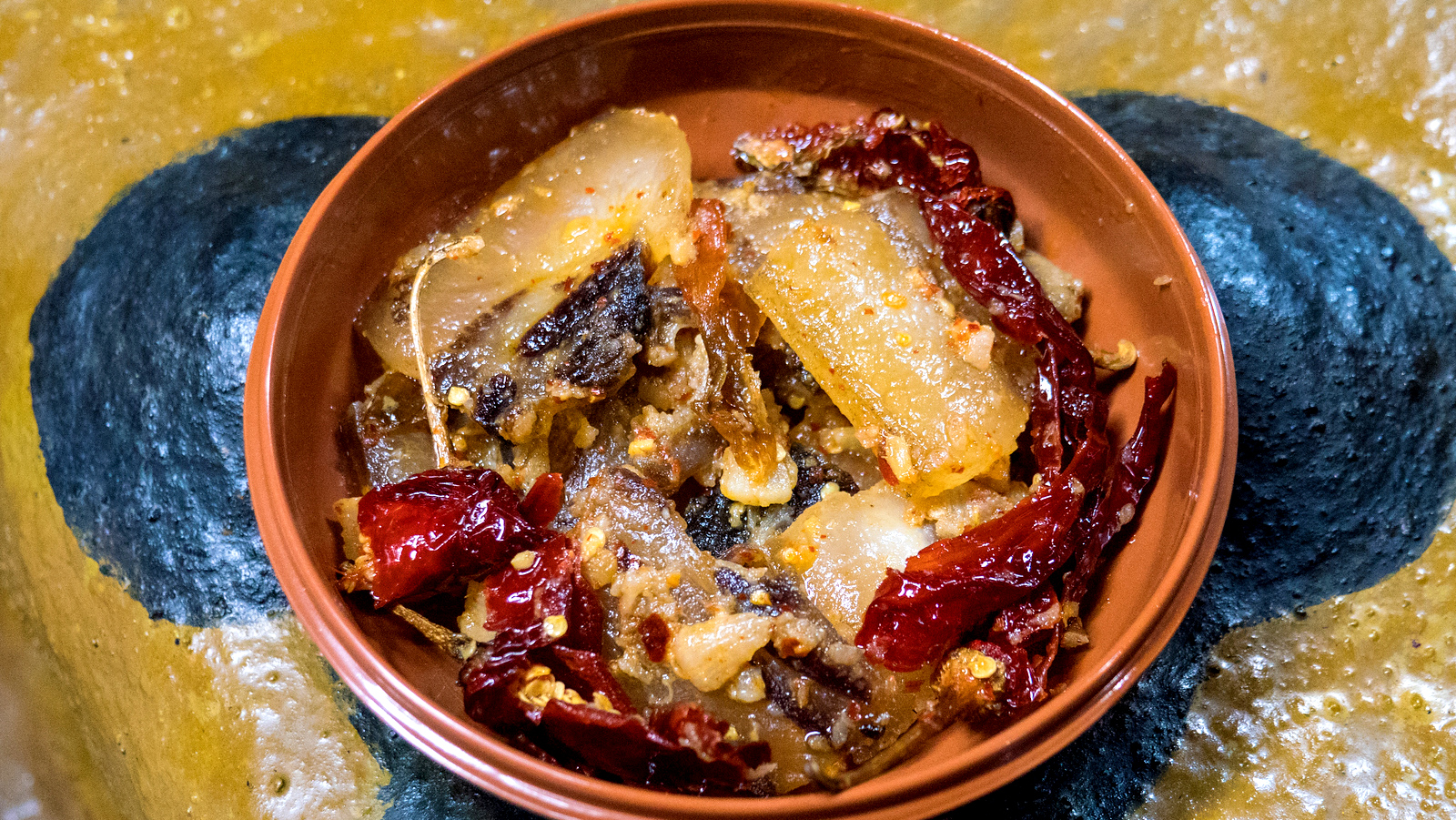
Ingredients
- Pork: Typically, the dish uses slices of pork belly or other fatty cuts, which add richness and depth.
- Dried Red Chilies: Essential for their heat and flavor, these chilies are a staple in Bhutanese cooking.
- Radishes or Turnips: These vegetables add a slight bitterness and texture to the dish, balancing the richness of the pork.
- Bok Choy or Spinach: Greens are added for a touch of freshness and to complement the other hearty flavors.
- Ginger and Garlic: These aromatics are key in building the foundational flavors of the dish.
- Seasoning: Commonly, the dish is flavored with salt, Bhutanese Sichuan pepper (known locally as "thingay"), and sometimes a splash of soy sauce for added depth.
Preparation
The preparation of Phaksha Paa starts with frying the pork in its own fat until it begins to brown, which enhances the flavor and texture. Garlic, ginger, and slices of radishes or turnips are then added to the pan and sautéed until they start to soften. Water or broth is poured over the ingredients, and the dish is left to simmer. The dried red chilies and greens are added towards the end of cooking, ensuring that the chilies soften while retaining their vibrant color and spicy flavor. The stew is simmered until the pork is tender and the vegetables are cooked through.
Serving
Phaksha Paa is typically served with steamed Bhutanese red rice, which complements the spicy and rich flavors of the stew. The rice provides a soothing balance to the heat from the chilies, making the meal both satisfying and comforting.
This dish showcases the Bhutanese penchant for balancing rich meats with bold spices and simple vegetables, creating flavors that are deep and complex. Phaksha Paa is not just a culinary treat but also a reflection of Bhutan's resourceful use of local ingredients and traditional cooking techniques.
Red Rice
Red Rice is a distinctive and integral component of Bhutanese cuisine, celebrated for its nutritional benefits and unique flavor profile. Grown primarily in the fertile valleys of Bhutan, this whole grain rice variety is not just a staple food but also a cultural symbol, showcasing the agricultural heritage of the Himalayan kingdom.
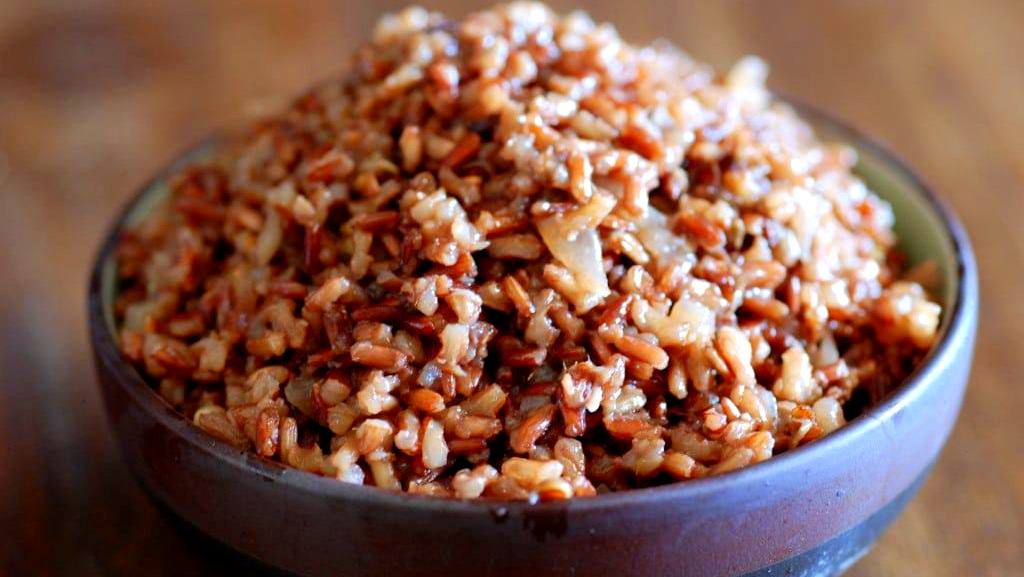
Characteristics
- Color: The rice has a reddish-brown outer hull, which gives it its characteristic color.
- Texture: When cooked, Bhutanese red rice has a somewhat sticky texture but is firmer and chewier than white rice.
- Flavor: It possesses a nutty taste, which complements a variety of dishes, from spicy stews to simple vegetables.
Nutritional Value
Bhutanese red rice is rich in minerals like magnesium and phosphorus and is a good source of fiber. It is also lower in calories compared to white rice, making it a healthier option for those conscious about their diet.
Culinary Uses
Red rice is versatile and can be used in a multitude of dishes. It is often served as a base for stews and curries, such as Ema Datshi or Jasha Maru, where it absorbs the flavors of the sauces. Its robust texture and nutty flavor make it an excellent component in salads, pilafs, or even as a side dish on its own, simply seasoned with butter and salt.
Cooking Tips
To cook red rice:
- Rinse the rice thoroughly in cold water until the water runs clear.
- Use about one and a half to two cups of water per cup of rice, depending on how soft you like your rice.
- Bring the water to a boil, add the rice, reduce the heat, cover, and simmer for about 20-30 minutes or until the grains are tender and all the water has been absorbed.
- Let it sit covered for a few minutes after cooking to allow the grains to firm up slightly, then fluff with a fork before serving.
Serving
In Bhutan, red rice is not just a culinary ingredient but a way of life. It is typically eaten with every main meal and is a perfect accompaniment to the bold flavors of Bhutanese cuisine. The rice's ability to complement both vegetarian and meat dishes makes it a versatile choice in the Bhutanese diet.
Red rice enriches the gastronomic landscape of Bhutan, offering both health benefits and a delightful eating experience. Its inclusion in meals underscores the Bhutanese commitment to natural, wholesome foods, a principle deeply embedded in the country's culinary practices.
Momos
Momos are a beloved staple in Bhutanese cuisine, widely enjoyed across the Himalayan region. These steamed dumplings have roots in Tibetan cooking but have become an integral part of Bhutanese food culture, where they are savored for their delightful taste and comforting qualities.
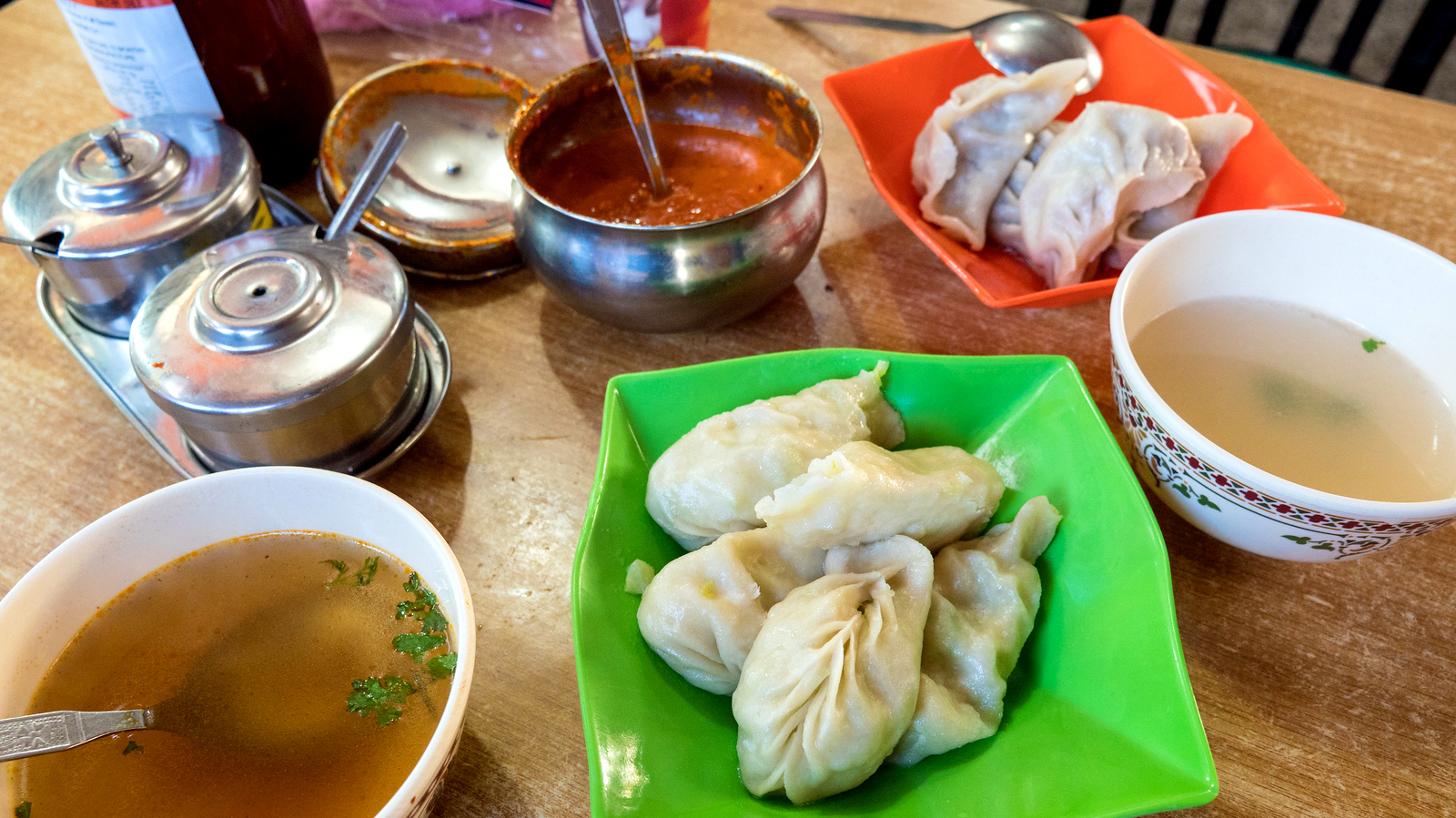
Ingredients
- Dough: Made from a simple mixture of flour and water, the dough for momos is rolled out into small, thin circles.
- Filling: Common fillings include minced meat (typically chicken, pork, or beef), finely chopped vegetables (like cabbage, carrots, and onions), or a combination of both. The filling is often seasoned with salt, pepper, garlic, and sometimes ginger for added flavor.
- Dipping Sauce: Momos are usually served with a spicy dipping sauce, known as 'ezay', which can be made from tomatoes, chili peppers, cilantro, and various spices.
Preparation
- Making the Dough: The dough is kneaded until smooth and elastic, then divided into small balls and rolled into thin circles.
- Preparing the Filling: The chosen filling ingredients are mixed together and seasoned. For meat fillings, ingredients are usually cooked slightly to ensure they are fully cooked when steamed.
- Assembling the Momos: A small amount of filling is placed in the center of each dough circle. The dough is then folded over the filling and sealed by pinching the edges together, creating pleats. The top is often twisted to ensure the filling is enclosed completely.
- Steaming: The assembled momos are placed in a steamer lined with cabbage leaves or oil to prevent sticking. They are steamed for about 10-15 minutes until the dough becomes glossy and translucent.
Serving
Momos are typically served hot, straight from the steamer, accompanied by the spicy ezay dipping sauce. They can be a snack on their own or part of a larger meal, often enjoyed during gatherings and special occasions.
Cultural Significance
In Bhutan, momos are more than just a dish; they are a part of social and family gatherings. Making momos is often a communal activity where family members or friends come together to prepare the dish, making it a bonding experience.
Momos represent a delicious example of Himalayan cuisine's simplicity and flavor. They are a favorite among both locals and tourists, offering a taste of Bhutan's rich culinary traditions in each bite. Whether enjoyed in a festive setting or as a comfort food on a regular day, momos are a cherished part of Bhutanese cuisine.
Suja
Suja, also known as butter tea, is a distinctive and traditional beverage in Bhutan, deeply embedded in the daily life and hospitality of the Bhutanese people. This unique drink is made from tea leaves, butter, and salt, offering a flavor that is both intriguing and comforting, especially in the cold Himalayan climate.
.jpg)
Ingredients
- Tea Leaves: Typically, a strong black tea, often a variety called Pemagul Black Tea, is used.
- Butter: The butter used in Suja is traditionally made from yak milk, which gives the tea a rich and creamy texture.
- Salt: A pinch of salt is added to enhance the flavors and balance the richness of the butter.
Preparation
- Brewing the Tea: The tea leaves are boiled in water for several minutes to create a strong brew.
- Churning: The brewed tea, butter, and salt are then combined in a churn or blender. The mixture is churned or blended vigorously to create a smooth, emulsified beverage. This process is essential to ensure that the butter and tea blend well, preventing the butter from separating.
- Simmering: In some traditions, the mixture may be simmered gently after churning to enhance the flavors and ensure everything is well integrated.
Serving
Suja is traditionally served hot and is a staple in Bhutanese households. It is typically consumed in small bowls or cups and is often offered to guests as a gesture of welcome and warmth. Suja is not only a drink but also a vital part of Bhutanese culture, consumed throughout the day to provide energy and warmth.
Cultural Significance
Butter tea plays a significant role in Bhutanese society. It is particularly valued for its high caloric content and ability to warm the body, which is essential in the high altitudes where cold weather prevails. Suja is also a staple during social gatherings, religious ceremonies, and festivals, where it facilitates social bonding.
The rich, creamy texture and unique salty flavor of Suja make it an acquired taste for those not familiar with it. However, for the Bhutanese, it is a cherished beverage that complements the robust flavors of their cuisine and provides comfort and sustenance in their often harsh climate. Suja exemplifies the practical and communal aspects of Bhutanese culinary traditions, serving as a reminder of the adaptation to and reverence for the natural environment that characterizes Bhutan.
Lom
Lom is a traditional Bhutanese dish that showcases the ingenuity of local cuisine, particularly in its use of preserved vegetables. Made from dried turnip greens, Lom is a hearty and flavorful dish that is especially popular during the colder months in Bhutan when fresh vegetables are less available.
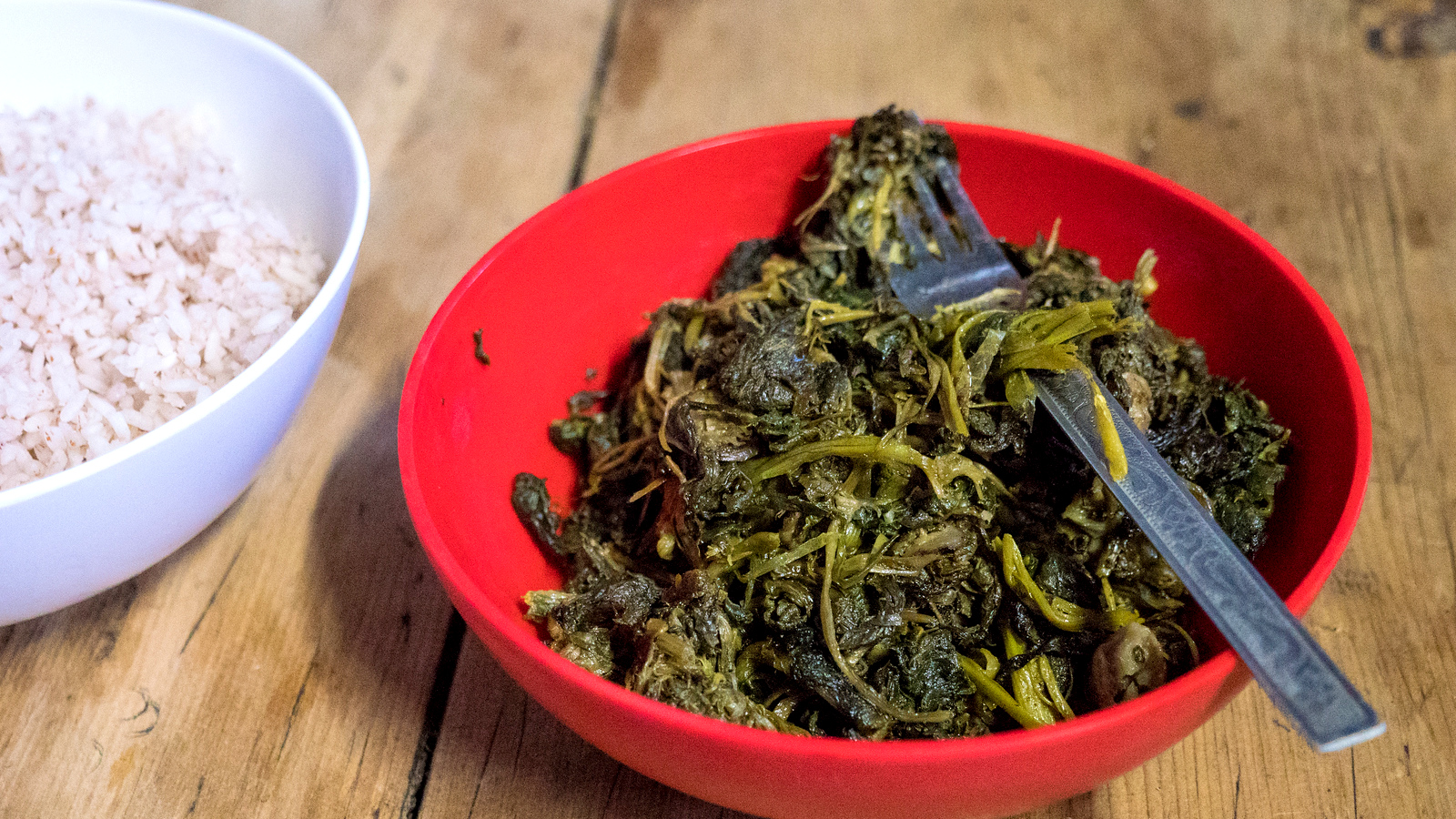
Ingredients
- Dried Turnip Greens (Lom): These are the centerpiece of the dish, providing a unique, slightly bitter taste and a chewy texture.
- Chilies: Fresh or dried chilies add a spicy kick to the dish.
- Meat: Often, Lom is cooked with pieces of pork or beef, which add richness and depth to the flavor.
- Garlic and Onions: These aromatics are used to enhance the overall flavor profile of the dish.
- Seasoning: The dish is typically seasoned with salt, and sometimes Bhutanese Sichuan pepper (known locally as "thingay") for an extra bit of spice and flavor.
Preparation
- Rehydrating the Greens: The dried turnip greens are first soaked in water to rehydrate them, making them softer and easier to cook.
- Cooking the Meat: If meat is being used, it is typically fried until browned and nearly cooked through.
- Adding Aromatics: Garlic and onions are added to the pan and sautéed with the meat to release their flavors.
- Incorporating the Greens: The rehydrated greens are then added to the pan along with chilies and additional water or broth as needed.
- Simmering: The mixture is allowed to simmer until all the ingredients are tender and the flavors have melded together.
Serving
Lom is usually served with a side of steamed rice or Bhutanese red rice, which complements the strong flavors of the dish. The rice also helps to balance the spiciness and the slight bitterness of the turnip greens.
Cultural Significance
Lom is a great example of how Bhutanese cuisine utilizes seasonal and preserved ingredients to maintain a nutritious diet throughout the year, especially in remote areas where fresh produce may be scarce during winter. It reflects the resourcefulness and adaptability of the Bhutanese people to their environment.
This dish not only provides a comforting warmth but also offers a taste of Bhutanese tradition, making it a beloved choice during the cold season. The use of dried vegetables like turnip greens in Lom is a culinary practice that helps sustain the Bhutanese through the harsher months, showcasing the importance of preservation techniques in their food culture.
The Flavor of Bhutan offers a captivating glimpse into the rich culinary traditions of this Himalayan kingdom. From the fiery heat of Ema Datshi to the comforting warmth of Jasha Maru, the robust textures of Phaksha Paa, and the unique nuttiness of Red Rice, Bhutanese cuisine is a delightful exploration of flavors and ingredients that are deeply rooted in the country's culture and geography. The simplicity of Momos, the traditional ritual of Suja, and the seasonal ingenuity of Lom further showcase the diversity and adaptability of Bhutanese cooking. Each dish not only satisfies the palate but also tells a story of cultural heritage, communal life, and a profound connection to the environment. For food lovers and cultural explorers alike, diving into the flavors of Bhutan is an enriching experience that goes beyond mere gastronomy to touch the essence of Bhutanese life and spirit.
FAQs of the Flavor of Bhutan: Savoring the Unique Bhutanese Cuisine
Q. What are the staple ingredients in Bhutanese cuisine?
Q. Is Bhutanese food very spicy?
A: Yes, Bhutanese cuisine is known for its spiciness, mainly due to the liberal use of chilies in most dishes, including the national dish, Ema Datshi, which is made primarily from chilies and cheese.
Q. Are there vegetarian options in Bhutanese cuisine?
A: While meat is a common component in many Bhutanese dishes, there are also numerous vegetarian options available. Dishes like Ema Datshi can be made without meat, and other vegetarian dishes include vegetable momos, red rice, and various vegetable curries.
Q. What makes Bhutanese red rice unique?
A: Bhutanese red rice is a whole grain that is grown at high altitudes in the Kingdom of Bhutan. It has a nutty flavor, is slightly sticky after cooking, and is richer in minerals and dietary fiber compared to white rice.
Q. How is traditional Bhutanese tea different from regular tea?
A: Traditional Bhutanese tea, known as Suja or butter tea, is made from tea leaves, butter, and salt. It’s a savory beverage that is quite different from sweet or milky teas found in other parts of the world, providing both sustenance and warmth in the cold Himalayan climate.
Q. Can I make Bhutanese dishes at home?
A: Absolutely! Many Bhutanese dishes can be prepared at home with ingredients that are available at international or Asian grocery stores. Staples like red rice, chilies, and basic spices are accessible in many places, allowing you to recreate dishes like Ema Datshi, Jasha Maru, and momos.
Q. What is a typical Bhutanese meal like?
A: A typical Bhutanese meal consists of a serving of red rice, a dish of Ema Datshi or another meat or vegetable curry, accompanied by side dishes of seasonal vegetables. Meals are usually communal, with dishes shared among all present.
Q. Are there any unique eating customs I should be aware of when dining in Bhutan?
A: In Bhutan, it is customary to say a short prayer or phrase like "Kayray" (meaning please eat) before starting to eat, and it’s common to be offered second and third helpings as a sign of hospitality. Refusing at first offer is part of polite manners, but one can accept the offer upon subsequent insistence.
Q. What are some must-try dishes for first-time visitors to Bhutan?
A: First-time visitors should try Ema Datshi, Jasha Maru, Phaksha Paa, and momos. These dishes provide a good overview of the typical flavors found in Bhutanese cuisine.
Q. Is Bhutanese cuisine influenced by other culinary traditions?
A: Yes, Bhutanese cuisine shares some similarities with the cuisines of its neighbors, Tibet and India, featuring momos (Tibetan dumplings) and the use of spices and cooking techniques similar to those found in Indian cuisine. However, it also retains distinct characteristics that are uniquely Bhutanese.


